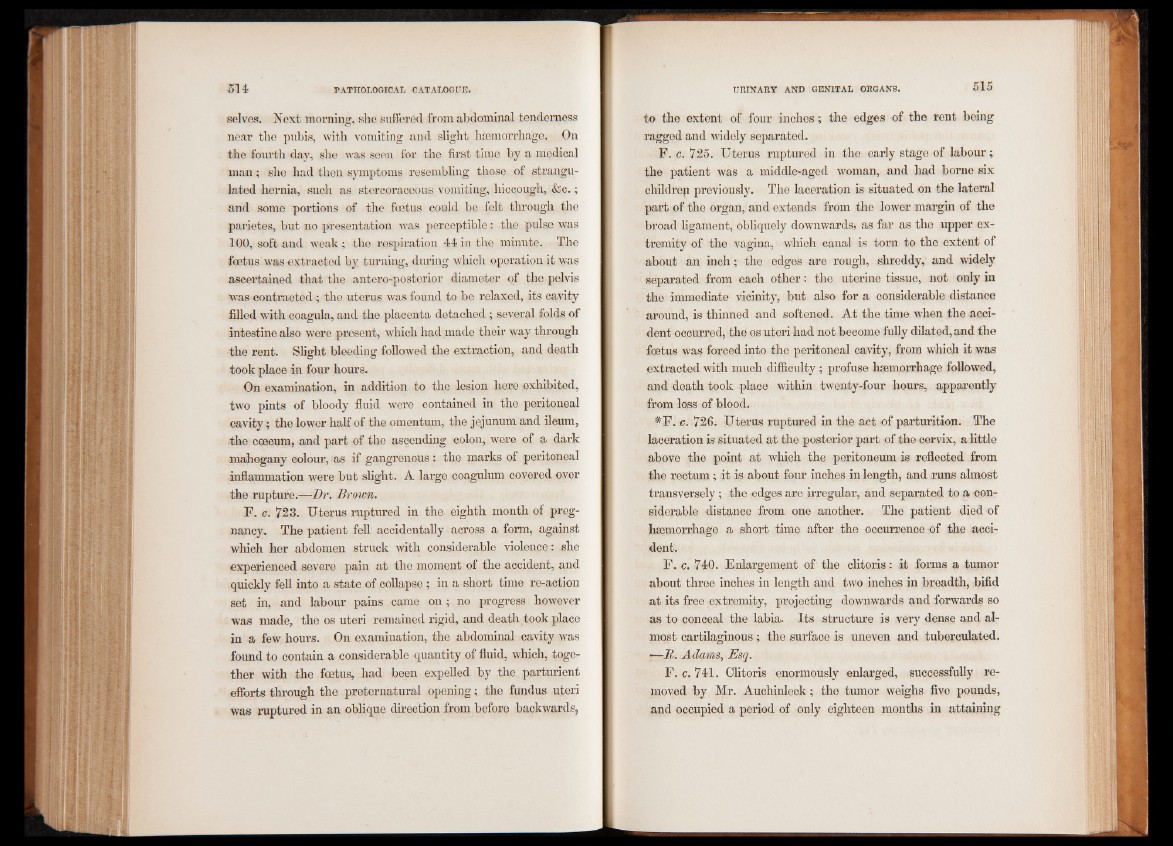
selves. Next morning, she suffered from abdominal tenderness
near the pubis, with vomiting and slight hæmorrhage. On
the fourth day, she was seen for the first time by a medical
man ; she had then symptoms resembling those of strangulated
hernia, such as stercoraceous vomiting, hiccough, &c. ;
and some portions of the foetus could be felt through the
parietes, but no presentation was perceptible : the pulse was
100, soft and weak; the respiration 44 in the minute. The
foetus was extracted by turning, during which operation it was
ascertained that the antero-posterior diameter of the pelvis
was contracted ; the uterus was found to be relaxed, its cavity
filled with coagula, and the placenta detached ; several folds of
intestine also were present, which had made their way through
the rent. Slight bleeding followed the extraction, and death
took place in four hours.
On examination, in addition to the lesion here exhibited,
two pints of bloody fluid were contained in the peritoneal
cavity ; the lower half of the omentum, the jejunum and ileum,
the cæcum, and part of the ascending colon, were of a dark
mahogany colour, as if gangrenous : the marks of peritoneal
inflammation were but slight. A large coagulum covered over
the rupture.—Dr. Brown.
F. c. 723. Uterus ruptured in the eighth month of pregnancy.
The patient fell accidentally across a form, against
which her abdomen struck with considerable violence: she
experienced severe pain at the moment of the accident, and
quickly fell into a state of collapse ; in a short time re-action
set in, and labour pains came on ; no progress however
was made, the os uteri remained rigid, and death took place
in a few hours. On examination, the abdominal cavity was
found to contain a considerable quantity of fluid, which, together
with the foetus, had been expelled by the parturient
efforts through the preternatural opening ; the fundus uteri
was ruptured in an oblique direction from before backwards,
to the extent of four inches; the edges of the rent being
ragged and widely separated.
F. c. 725. Uterus ruptured in the early stage of labour;
the patient was a middle-aged woman, and had borne six
children previously. The laceration is situated on the lateral
part of the organ, and extends from the lower margin of the
broad ligament, obliquely downwards, as far as the upper extremity
of the vagina, which canal is torn to the extent of
about an inch; the edges are rough, shreddy, and widely
separated from each other: the uterine tissue, not only in
the immediate vicinity, but also for a considerable distance
around, is thinned and softened. At the time when the accident
occurred, the os uteri had not become fully dilated, and the
foetus was forced into the peritoneal cavity, from which it was
extracted with much difficulty ; profuse haemorrhage followed,
and death took place within twenty-four hours, apparently
from loss of blood.
#F. c. 726. Uterus ruptured in the act of parturition. The
laceration is situated at the post erior part of the cervix, a little
above the point at which the peritoneum is reflected from
the rectum; it is about four inches in length, and runs almost
transversely; the edges are irregular, and separated to a considerable
distance from one another. The patient died of
haemorrhage a short time after the occurrence of the accident.
F. c. 740. Enlargement of the clitoris: it forms a tumor
about three inches in length and two inches in breadth, bifid
at its free extremity, projecting downwards and forwards so
as to conceal the labia. Its structure is very dense and almost
cartilaginous ; the surface is uneven and tuberculated.
—li. Adams, Esq.
F. c. 741. Clitoris enormously enlarged, successfully removed
by Mr. Auchinleck; the tumor weighs five pounds,
and occupied a period of only eighteen months in attaining